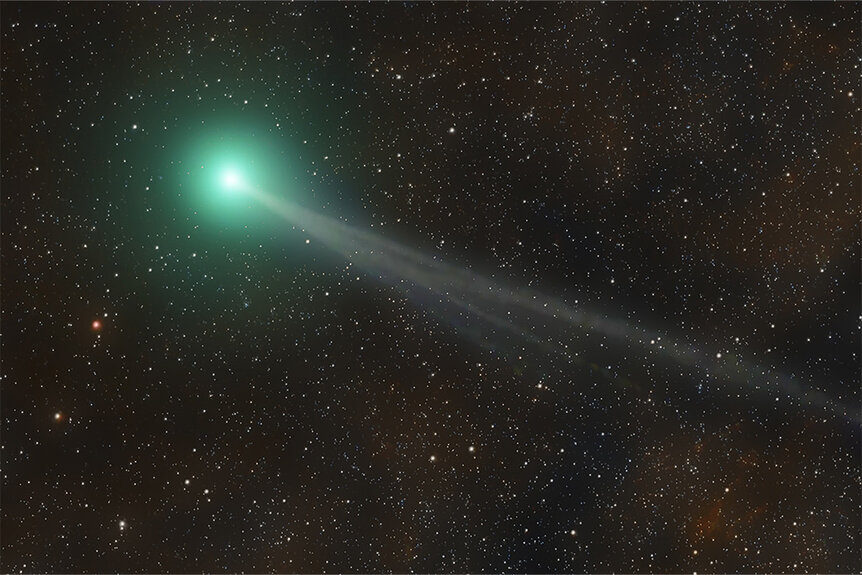Create a free profile to get unlimited access to exclusive videos, sweepstakes, and more!
Comet Tsuchinshan-ATLAS Visits Once every 80,000 Years: Here's How to See It
This comet has visited Earth only a few times since the birth of our species.

The science fiction family adventure Aliens Abducted my Parents and Now I Feel Kinda Left Out (now streaming on Peacock) opens with an interplanetary missing persons case. A young boy’s parents vanish within minutes of one another while the fictional comet Jesper passes by overhead. Ten years later, that boy (Jacob Buster) is convinced his parents were abducted by aliens following the comet’s (cotton candy flavored) tail, and he’s planning to catch up with them when the comet returns. Soon, real-world skywatchers will get a chance to see the recently discovered comet C/2023 A3 Tsuchinshan-ATLAS and it will be our only chance. The comet won’t be back for 80,000 years.
A comet like the fictional Jesper is what’s known as a Jupiter family comet, so named because they have orbits which extend roughly to the orbit of Jupiter. Most comets, however, are more distant. Many have roughly circular orbits which keep them in the outer reaches of the solar system, but some end up in highly elliptical orbits which take them back and forth between deep space and our neck of the woods.
No matter where a comet comes from, they are all made of more or less the same stuff: big bundles of ice and dust left over from the formation of the solar system. As they approach the Sun, they heat up and the comet’s nucleus begins shedding gas. That gas creates a coma around the nucleus and a long tail stretching away from the Sun.
What kind of comet is C/2023 A3 Tsuchinshan-ATLAS?
Aside from those hanging out around Jupiter, comets come in two main types: short-period and long-period comets. The former have orbits lasting 200 years or fewer. The most famous short-period comet is named for Edmond Halley and returns roughly once in a human lifetime, every 76 years. Mark Twain was famously born as Halley’s comet cut across the sky in 1835 and he died during Halley’s next visit in 1910, fulfilling his own prophecy that he came in with the comet and he would go out with it, too.
Short-period comets are beloved because they operate on timescales we can appreciate, albeit infrequently. Long-period comets are on another level entirely. These objects originate from the Oort Cloud, a vast sphere of ice and dust stretching up to 2 light-years away from the Sun. Long-period comets have orbital periods lasting tens of thousands of years or longer. That’s where the comet Tsuchinshan-ATLAS comes from.
The comet was first discovered in 2023, identified by observers at the Purple Mountain Observatory in China and an Asteroid Terrestrial-Impact Last Alert System (ATLAS) telescope in South Africa. The comet was named for both observatories. Based on its orbital trajectory, astronomers estimate it visits the inner solar system once every 80,000 years. The life cycle of Tsuchinshan-ATLAS is so long that it has visited the Earth only three or four times since the birth of humanity.
The comet made its closest approach with the Sun (perihelion) on September 27, 2024. It wasn’t clear ahead of time if the comet would survive the pass, comets are commonly ripped apart by the combination of heat and gravitational pressure, but Tsuchinshan-ATLAS made it through. Now it’s on its way back toward deep space. Along the way, it will pass by the Earth, getting about 44 million miles away on October 12.
How to See the Comet Tsuchinshan-ATLAS
Recently, the comet has been obscured by the glare of the Sun, but it will soon become visible in the Northern Hemisphere, just above the horizon after sunset. Look to the west, about 10 degrees above the horizon, between the constellations of Sagittarius and Scorpio.
Tsuchinshan-ATLAS is expected to be about as bright as Jupiter, bright enough to see with the unaided eye, for the rest of October and into early November, according to NASA. The comet itself is only about 2 miles across, but its tail will stretch millions of miles across space. Unlike meteors, which streak rapidly across the sky, comets appear more static, shifting their apparent position night over night instead of second over second. If you have trouble seeing the comet over the next couple of days, visibility may become easier thereafter, as the comet rises higher into the sky.
While the comet is expected to remain visible to the naked eye for a couple of weeks, binoculars or a small telescope will only enhance the view. If you missed the passing of Halley’s comet in 1986 and you’re not keen to wait for it to come back in 2061, this is your chance for an ever-rarer astronomical event.
Keep up with the comets in Aliens Abducted my Parents and Now I Feel Kinda Left Out, streaming now on Peacock.




























